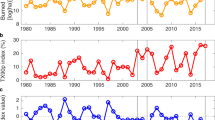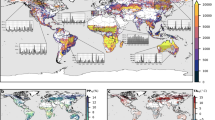Abstract
Borneo’s diverse ecosystems, which are typical humid tropical conditions, are deteriorating rapidly, as the area is experiencing recurrent large-scale wildfires, affecting atmospheric composition1,2,3,4 and influencing regional climate processes5,6. Studies suggest that climate-driven drought regulates wildfires2,7,8,9, but these overlook subsurface processes leading to hydrological drought, an important driver. Here, we show that models which include hydrological processes better predict area burnt than those solely based on climate data. We report that the Borneo landscape10 has experienced a substantial hydrological drying trend since the early twentieth century, leading to progressive tree mortality, more severe than in other tropical regions11. This has caused massive wildfires in lowland Borneo during the past two decades, which we show are clustered in years with large areas of hydrological drought coinciding with strong El Niño events. Statistical modelling evidence shows amplifying wildfires and greater area burnt in response to El Niño/Southern Oscillation (ENSO) strength, when hydrology is considered. These results highlight the importance of considering hydrological drought for wildfire prediction, and we recommend that hydrology should be considered in future studies of the impact of projected ENSO strength, including effects on tropical ecosystems, and biodiversity conservation.
This is a preview of subscription content, access via your institution
Access options
Access Nature and 54 other Nature Portfolio journals
Get Nature+, our best-value online-access subscription
$29.99 / 30 days
cancel any time
Subscribe to this journal
Receive 12 print issues and online access
$209.00 per year
only $17.42 per issue
Buy this article
- Purchase on Springer Link
- Instant access to full article PDF
Prices may be subject to local taxes which are calculated during checkout



Similar content being viewed by others
References
Thompson, A. M. et al. Tropical tropospheric ozone and biomass burning. Science 291, 2128–2132 (2001).
Page, S. E. et al. The amount of carbon released from peat and forest fires in Indonesia during 1997. Nature 420, 61–65 (2002).
Novelli, P. C. et al. Reanalysis of tropospheric CO trends: effects of the 1997–1998 wildfires. J. Geophys. Res. 108, 4464 (2003).
Huijnen, V. et al. Fire carbon emissions over maritime southeast Asia in 2015 largest since 1997. Sci. Rep. 6, 26886 (2016).
Hoffmann, W. A., Schroeder, W. & Jackson, R. B. Regional feedbacks among fire, climate, and tropical deforestation. J. Geophys. Res. 108, 4721 (2003).
Van der Molen, M. K., Dolman, A. J., Waterloo, M. J. & Bruijnzeel, L. A. Climate is affected more by maritime than by continental land use change: a multiple scale analysis. Glob. Planet. Change 54, 128–149 (2006).
Van der Werf, G. R., Randerson, J. T., Giglio, L., Gobron, N. & Dolman, A. J. Climate controls on the variability of fires in the tropics and subtropics. Glob. Biogeochem. Cycles 22, GB3028 (2008).
Fu, R. et al. Increased dry-season length over southern Amazonia in recent decades and its implication for future climate projection. Proc. Natl Acad. Sci. USA 110, 18110–18115 (2013).
Jolly, W. M. et al. Climate-induced variations in global wildfire danger from 1979 to 2013. Nat. Commun. 6, 7537 (2015).
Kier, G. et al. Global patterns of plant diversity and floristic knowledge. J. Biogeogr. 32, 1107–1116 (2005).
Phillips, O. L. et al. Drought–mortality relationships for tropical forests. New Phytol. 187, 631–646 (2010).
Beaman, J. Mount Kinabalu: hotspot of plant diversity in Borneo. Biol. Skr. 55, 103–127 (2005).
Dai, A. G. Increasing drought under global warming in observations and models. Nat. Clim. Change 3, 52–58 (2013).
Fernandes, K. et al. Heightened fire probability in Indonesia in non-drought conditions: the effect of increasing temperatures. Environ. Res. Lett. http://dx.doi.org/10.1088/1748-9326/aa6884 (2017).
Marlier, M. E. et al. El Niño and health risks from landscape fire emissions in southeast Asia. Nat. Clim. Change 3, 131–136 (2013).
Wösten, J. H. M., Clymans, E., Page, S. E., Rieley, J. O. & Limin, S. H. Peat–water interrelationships in a tropical peatland ecosystem in Southeast Asia. CATENA 73, 212–224 (2008).
Hoscilo, A., Page, S. E., Tansey, K. J. & Rieley, J. O. Effect of repeated fires on land-cover change on peatland in southern Central Kalimantan, Indonesia, from 1973 to 2005. Int. J. Wildland Fire 20, 578–588 (2011).
Taufik, M., Setiawan, B. I. & Van Lanen, H. A. J. Modification of a fire drought index for tropical wetland ecosystems by including water table depth. Agric. For. Meteorol. 203, 1–10 (2015).
Turetsky, M. R. et al. Global vulnerability of peatlands to fire and carbon loss. Nat. Geosci. 8, 11–14 (2015).
Harris, I., Jones, P. D., Osborn, T. J. & Lister, D. H. Updated high-resolution grids of monthly climatic observations—the CRU TS3.10 Dataset. Int. J. Climatol. 34, 623–642 (2014).
Van Loon, A. F. & Van Lanen, H. A. J. A process-based typology of hydrological drought. Hydrol. Earth Syst. Sci. 16, 1915–1946 (2012).
Giglio, L., Randerson, J. T. & Van der Werf, G. R. Analysis of daily, monthly, and annual burned area using the fourth-generation global fire emissions database (GFED4). J. Geophys. Res. 118, 317–328 (2013).
Yang, Y., Uddstrom, M., Pearce, G. & Revell, M. Reformulation of the drought code in the Canadian fire weather index system implemented in New Zealand. J. Appl. Meteorol. Climatol. 54, 1523–1537 (2015).
Cleveland, W. S. & Devlin, S. J. Locally weighted regression: an approach to regression analysis by local fitting. J. Am. Stat. Assoc. 83, 596–610 (1988).
Breiman, L. Random forests. Mach. Learn. 45, 5–32 (2001).
Field, R. D. et al. Development of a global fire weather database. Nat. Hazards Earth Syst. Sci. 15, 1407–1423 (2015).
Moriasi, D. N. et al. Model evaluation guidelines for systematic quantification of accuracy in watershed simulations. Trans. ASABE 50, 885–900 (2007).
Cai, W. et al. Increasing frequency of extreme El Niño events due to greenhouse warming. Nat. Clim. Change 5, 1–6 (2014).
Cai, W. et al. ENSO and greenhouse warming. Nat. Clim. Change 5, 849–859 (2015).
Van Lanen, H. A. J., Wanders, N., Tallaksen, L. M. & Van Loon, A. F. Hydrological drought across the world: impact of climate and physical catchment structure. Hydrol. Earth Syst. Sci. 17, 1715–1732 (2013).
Wanders, N. & Van Lanen, H. A. J. Future discharge drought across climate regions around the world modelled with a synthetic hydrological modelling approach forced by three general circulation models. Nat. Hazards Earth Syst. Sci. 15, 487–504 (2015).
Hoekman, D. H., Vissers, M. A. M. & Wielaard, N. PALSAR wide-area mapping of Borneo: methodology and map validation. IEEE J. Sel. Top. Appl. Earth Obs. Remote Sens. 3, 605–617 (2010).
Koh, L. P., Miettinen, J., Liew, S. C. & Ghazoul, J. Remotely sensed evidence of tropical peatland conversion to oil palm. Proc. Natl Acad. Sci. USA 108, 5127–5132 (2011).
Carlson, K. M. et al. Carbon emissions from forest conversion by Kalimantan oil palm plantations. Nat. Clim. Change 3, 283–287 (2012).
Langner, A., Miettinen, J. & Siegert, F. Land cover change 2002–2005 in Borneo and the role of fire derived from MODIS imagery. Glob. Change Biol. 13, 2329–2340 (2007).
Tallaksen, L. M., Hisdal, H. & Van Lanen, H. A. J. Space-time modelling of catchment scale drought characteristics. J. Hydrol. 375, 363–372 (2009).
Wooster, M. J., Perry, G. L. W. & Zoumas, A. Fire, drought and El Niño relationships on Borneo (Southeast Asia) in the pre-MODIS era (1980–2000). Biogeosciences 9, 317–340 (2012).
Walsh, R. P. D. Drought frequency changes in Sabah and adjacent parts of northern Borneo since the late nineteenth century and possible implications for tropical rain forest dynamics. J. Trop. Ecol. 12, 385–407 (1996).
Walsh, R. P. D. & Newbery, D. M. The ecoclimatology of Danum, Sabah, in the context of the world’s rainforest regions, with particular reference to dry periods and their impact. Phil. Trans. R. Soc. Lond. B 354, 1869–1883 (1999).
Newbery, D. M. & Lingenfelder, M. Resistance of a lowland rain forest to increasing drought intensity in Sabah, Borneo. J. Trop. Ecol. 20, 613–624 (2004).
Gupta, H. V., Kling, H., Yilmaz, K. K. & Martinez, G. F. Decomposition of the mean squared error and NSE performance criteria: implications for improving hydrological modelling. J. Hydrol. 377, 80–91 (2009).
R Development Core Team. R: A Language and Environment for Statistical Computing (R Foundation for Statistical Computing, 2011).
Wickham, H. ggplot2: Elegant Graphics for Data Analysis (Springer, 2009).
Malingreau, J. P., Stephens, G. & Fellows, L. Remote sensing of forest fires: Kalimantan and North Borneo in 1982–83. Ambio 14, 314–321 (1985).
Acknowledgements
This present study was completed with support of DIKTI Scholarship (contract no: 4115/E4.4/K/2013) and project SPIN-JRP-29 granted by Royal Netherlands Academy of Arts and Sciences (KNAW). It contributes to WIMEK-SENSE and UNESCO IHP-VIII programme FRIEND-Water. D.M.’s time is supported by USAID grant through SWAMP.
Author information
Authors and Affiliations
Contributions
M.T. and H.A.J.V.L. conceived and implemented the research. M.T. and P.J.J.F.T. performed data analysis. M.T. and H.A.J.V.L. wrote the initial version of the paper. M.T. performed model output analysis and generated all figures. All authors contributed to interpreting results, discussion of the associated dynamics and improvement of this paper.
Corresponding author
Ethics declarations
Competing interests
The authors declare no competing financial interests.
Supplementary information
Supplementary Information
Supplementary Information (PDF 2282 kb)
Rights and permissions
About this article
Cite this article
Taufik, M., Torfs, P., Uijlenhoet, R. et al. Amplification of wildfire area burnt by hydrological drought in the humid tropics. Nature Clim Change 7, 428–431 (2017). https://doi.org/10.1038/nclimate3280
Received:
Accepted:
Published:
Issue Date:
DOI: https://doi.org/10.1038/nclimate3280
This article is cited by
-
Assessing the Effect of Future Climate Change on Drought Characteristics and Propagation from Meteorological to Hydrological Droughts—A Comparison of Three Indices
Water Resources Management (2024)
-
A dry-wet teleconnection between southwestern and northeastern China in winter and early spring
Climate Dynamics (2024)
-
Exploring EM-DAT for depicting spatiotemporal trends of drought and wildfires and their connections with anthropogenic pressure
Natural Hazards (2024)
-
Peatland groundwater level in the Indonesian maritime continent as an alert for El Niño and moderate positive Indian Ocean dipole events
Scientific Reports (2023)
-
Accuracy of tropical peat and non-peat fire forecasts enhanced by simulating hydrology
Scientific Reports (2023)



